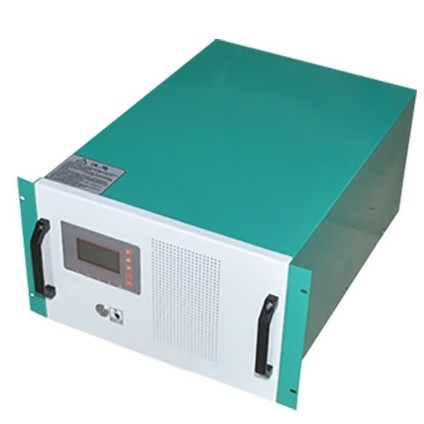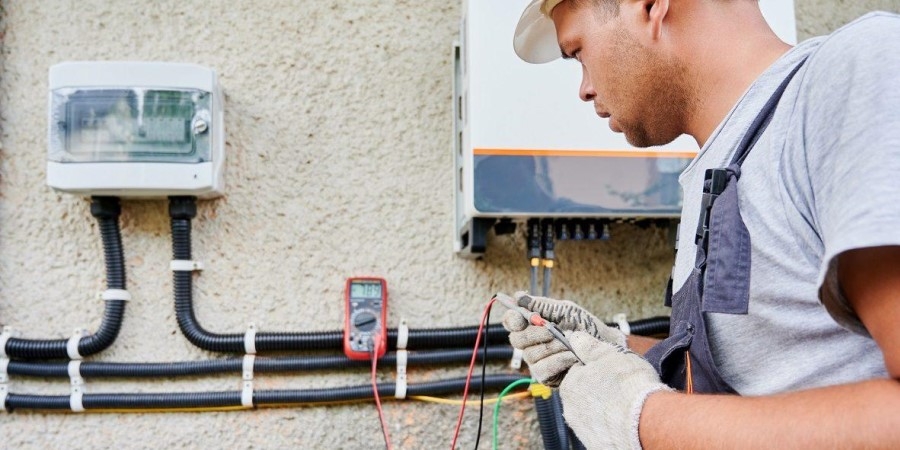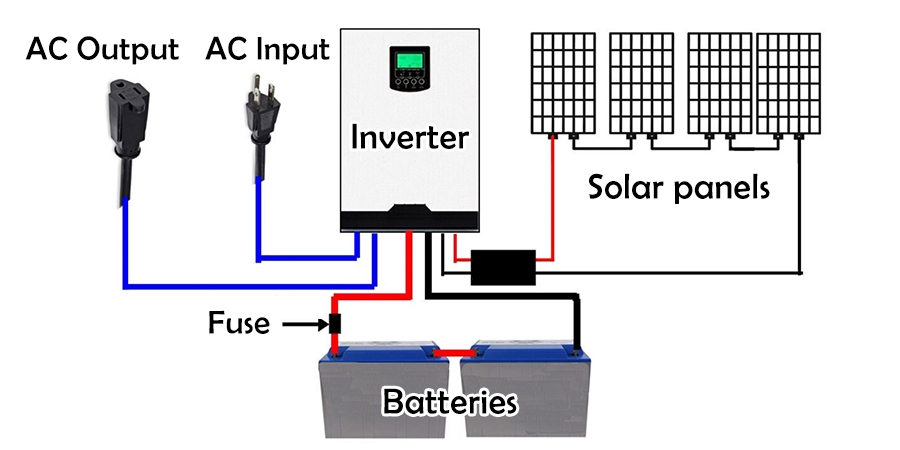With the energy crisis and environmental problems becoming more and more serious, renewable energy sources such as solar energy are being used more and more widely. Off-grid solar inverters, as an important part of the solar power systems, convert DC power into AC power to provide a convenient power supply for homes, businesses and so on. This blog will provide you with detailed information on how to install and use an off-grid solar inverter, as well as some handy tips on how to use it, so that you can better utilize this green energy source.
Basic Parameters of Off-grid Inverters

To get a better visualization of the Off-grid Inverter, we will analyze this 5kW off-grid inverter as an example:
Rated Output Power: 5KW
Rated Voltage: 96V/192V
Rated Output Voltage Range: 220VAC/380VAC
Phases: Single phase/three phase
Power is a measure of how fast energy is converted and tells us the amount of energy that is converted in a certain amount of time. 5kW off-grid inverter means that the maximum output power of this inverter is 5 kilowatts. In other words, it can work continuously until it converts 5 kilowatts of DC energy into AC energy.
The parameter rated voltage refers to the range of DC input voltages that can be accepted by the inverter. 96V/192V is the DC voltage value that represents the level of voltage that may be provided by the solar panel. If the input voltage is not within the specified range, the inverter may not function properly or may be damaged.
Rated output voltage and phase can be discussed together. Generally speaking, single-phase output, which means the inverter outputs a single AC power source with 220V, and three-phase output, which means it outputs three independent AC power sources with 380V. 220V is a low voltage, which is mainly used for home, business and light industry, while 380V belongs to the high voltage, which is mainly used for industrial and large-scale commercial power consumption. This off-grid inverter supports two output modes and has a wide range of application scenarios.
Installation and Use
After understanding the basic parameters of an off-grid inverter and what they represent, it is time to learn how to properly install and use it.
Installation of off-grid inverters
- Confirm the condition of the solar panel: The solar panel should be installed in a sunny place, avoiding shadows and coverings. Make sure that the distance between the solar panel and the solar inverter is moderate for connecting the wires. To ensure that the solar panel is compatible with the inverter, you need to choose a panel whose voltage and power match the input of the inverter.
- Using environment: The inverter should be installed in a well-ventilated, dry and easy-to-operate place. The suitable working temperature range of the above inverter should be between -15 °C and 55 °C, and it should be far away from the open fire source as well as the location of direct sunlight, and avoid running in dewy and dusty environment. In the process of use, a certain amount of heat generation is normal, but the installation environment should be kept ventilated to dissipate heat and clean.
- Wiring: Connect the output of the solar panel to the input of the inverter, pay attention to insulation and fixation; connect the output of the inverter to the load (such as lamps, electrical appliances, etc.). When connecting, make sure that the positive and negative poles are not connected incorrectly. At the same time, you need to confirm the voltage level of the load equipment, and its power should not be larger than the rated output power of the inverter power supply.
Off-grid inverter, as the name suggests, off-grid is the characteristic of this product, that is, it does not touch the power grid. Therefore, there is no need to connect the solar power system using off-grid inverter to the public grid. The following figure shows the basic wiring diagram of an off-grid inverter:
Use of off-grid inverters
- Start-up: After turning on the power, observe the working status of the inverter. When the solar panel has enough sunshine, the inverter will start automatically to convert solar energy to AC power.
- Monitoring: Check the working status of the inverter regularly, such as voltage, current, temperature and other parameters. If there is any abnormality, deal with it in time. This product has a LED display, which can easily and quickly check the working status and change the output mode, with intuitive and convenient operation.
- Protection and maintenance: In order to prevent accidents such as lightning strikes and overloads, protective equipment such as lightning rods and fuses can be installed near the inverter. Meanwhile, both solar panels and inverters need to be cleaned and maintained on a regular basis to keep them working efficiently and safely.
The above mentioned 5kW off-grid inverter has multiple protection functions, such as low-voltage protection, high-voltage protection, high-temperature protection, intelligent temperature control fan, and so on, which can ensure the long-term safe operation of the equipment.
Tips for Use
- Reasonable configuration of solar panels and inverters: Choose the right solar panels and solar inverters according to the load demand. Avoid over-investment and waste of resources. When selecting and using a solar power system, it is important to make sure that the rated power and input voltage of the inverter match the specifications of your solar panels. This will ensure safe and efficient operation of the system.
- Optimize load usage: Try to use high-efficiency and energy-saving electrical equipment to reduce the load and improve the utilization rate of solar power generation. According to different power needs, reasonably configure single-phase or three-phase output to optimize system performance.
- Pay attention to safety: When installing and using off-grid inverters, be sure to comply with relevant regulations to ensure personal and equipment safety.

Off-grid inverter, as an essential part of solar energy generation system, is crucial to install and use. Through the introduction of PowerHome, we hope you can better understand how to use off-grid inverters and fully utilize solar energy as a green energy source, contributing to the world's energy security and environmental protection.
The combination of off-grid inverters and solar power systems provides great convenience for remote areas and outdoor activities, enabling people to enjoy clean and sustainable energy. Although there are some technical problems and the disadvantage of higher price, with the progress of science and technology and the improvement of people's environmental protection consciousness, it is believed that in the future, the off-grid inverter and solar power generation system will be more widely used, and make a greater contribution to the sustainable development of mankind.
(1).png)

(1).png)